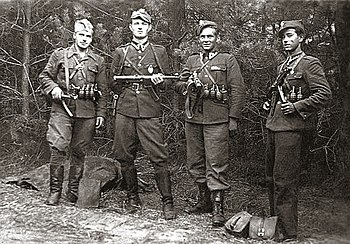Raids on communist prisons in Poland (1944–1946)
| Anti-communist resistance in Poland | |||||||
|---|---|---|---|---|---|---|---|
| Part of Eastern European anti-Communist insurgencies | |||||||
 "Cursed soldiers" of the anti-Communist underground. |
|||||||
|
|||||||
| Belligerents | |||||||
|
|
|
||||||
| Commanders and leaders | |||||||
|
August Emil Fieldorf Witold Pilecki Zygmunt Szendzielarz Józef Kuraś ...and others |
|
||||||
| Units involved | |||||||
| ...and others | |||||||
| Strength | |||||||
| 20,000 partisans | 2,000,000 Red Army soldiers 35,000 NKVD officers 24,000 Polish soldiers and Ministry of Public Security officers |
||||||
| Casualties and losses | |||||||
|
|||||||
| 10,000 civilians killed | |||||||
The anti-communist resistance in Poland (1944–1953), also referred to as the Polish anti-Communist insurrection, was an armed struggle by the Polish Underground against the Soviet takeover of Poland at the end of World War II in Europe. The guerrilla warfare conducted by the resistance movement formed during the war, included an array of military attacks launched against Communist prisons, state security offices, detention facilities for political prisoners, and prison camps set up across the country by the Soviet authorities.
In January 1945, the pro-Soviet government installed in Poland by the advancing Red Army declared the Polish anti-Nazi resistance movement, principally the Armia Krajowa (Home Army), to be illegal and asked its surviving members to come out into the open, guaranteeing them freedom and safety. Many underground fighters decided to lay down their arms, but after doing so, most of them were arrested and imprisoned; thousands were tortured, executed, or deported into the Soviet Gulag System.
As a result, Armia Krajowa (AK) members quickly stopped trusting the new government, and some of them regrouped in a clandestine manner in order to oppose the new Soviet occupiers. They formed various post-AK resistance organisations, such as Wolność i Niezawisłość ("Freedom and Sovereignty"), and liberated hundreds of political prisoners. They became known as the "Cursed soldiers" of the Polish underground, and most were eventually captured or killed by the security services and special assassination squads.
On the night of 3-4 January 1944 the advancing Red Army crossed the former eastern border of the Second Polish Republic in the area of Volhynia (near the village of Rokitno). In several months, they pushed the Wehrmacht further west, reaching the line of the Vistula river on 24 July 1944. The Soviet advance stopped short of Warsaw, while the Armia Krajowa attempted to liberate the Polish capital from the Nazis ahead of the Red Army's offensive. The Warsaw Uprising by forces loyal to the Polish government-in-exile in London was crushed after 63 days.
...
Wikipedia
